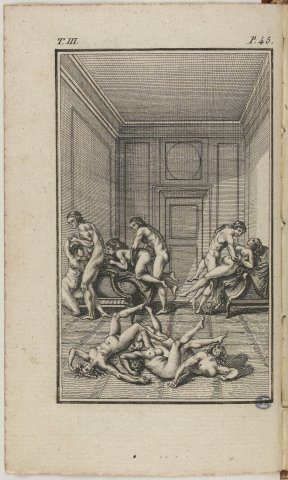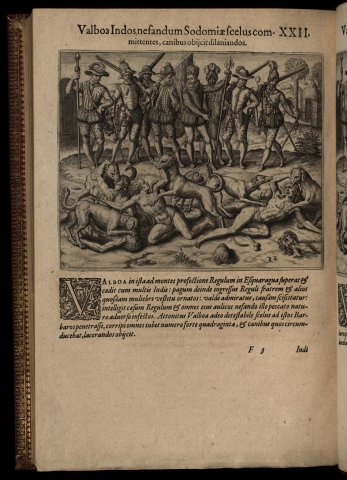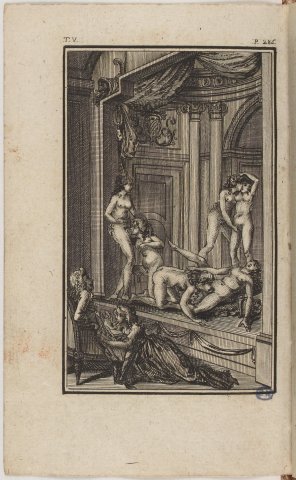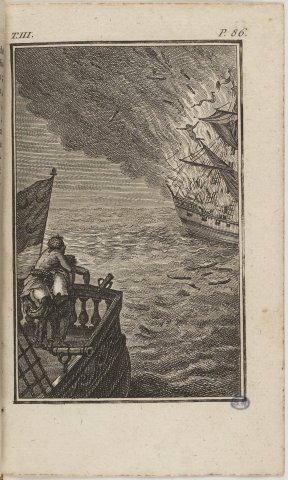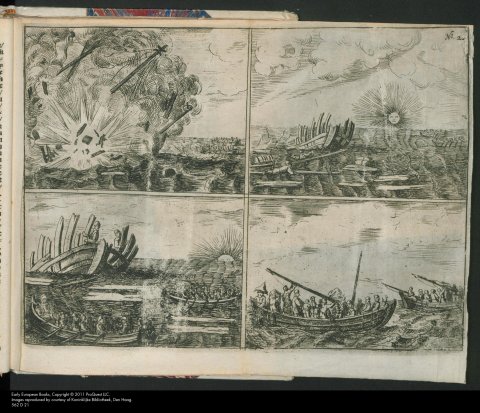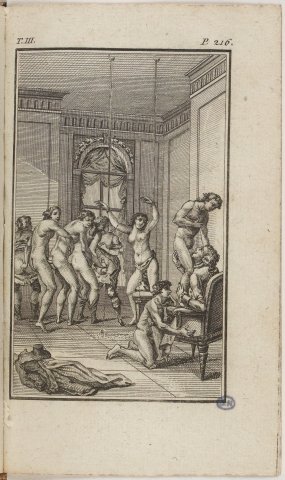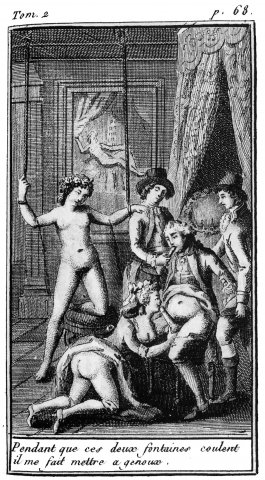The Sadian discourse seems to have lost its relevance today. The libertine's philosophy would be heard. Do we read Sade to learn that Heaven is empty, that the law of men, iniquitous or hypocritical, is only a decoy covering the natural law of the strongest, which is universally exercised ?
The same cannot be said of the Sadian scenario, which always fascinates and horrifies. Concurrently with the discourse it motivates, this scenario implements fearsome erotic tableaux. Sometimes these tableaux are illustrated; sometimes they are not. But independently even of the material presence of the image they manifest a persistent and disquieting efficacy, which we propose to analyze here.
First, of course, there's the obscene evidence of illustration. One must have had the experience, in the metro, on the train, in the salon des Lumières, in any public place open to the indiscretion of others' gaze, of reading Sade. Pages of text provide the perverse alibi of decency; no one pays any attention to the reader's collected withdrawal. In the social network of attentions, the pornographic book, with its neutral cover and wise typographical sequences, remains invisible. But the moment an illustration is discovered at the turn of a page, the situation changes radically. Perverse consumption (by both the text and the reader) is immediately exposed, embarrassed and disturbed: what the image brutally reveals is not only the obscenity of the content, but also the exhibitionist perversity of a reading situation. Mute, the discomfort is shared. It's impossible to look peacefully at the print on the page, which quickly demands to be turned. The book, on the other hand, has become visible and polarizes the social space it concentrates attention and disseminates its effect, reverberating outside itself the very intrinsic play of the erotic image : compression-dissemination such is indeed, in this matter, the watchword of effectiveness.
.
There's a paradox of efficiency : focusing all attention, the pornographic image doesn't exactly emerge to be seen, but rather as defeated theatricality, as the pulsating drive to see, between exhibition and prohibition. It makes fiction socially visible, and at the same time blurs its visibility; it opens the perverse scenario to the social objectification of seeing, and closes it in the incommunicability of its shameful obscenity. An image that cannot be unseen and which, precisely because of this attention, is hidden from view.
On the surface, nothing in the Sadian text echoes this pulsation of shame and exhibition : the libertine flaunts his impudence and impunity, deploying the discourse, the system, of it at pleasure. Horror, the expression of the slightest reserve, are the prerogative of the victims, immediately reinvested in additional enjoyment. Narration has no state of mind. But narration is not the fictional matrix of storytelling, which it instead covers with a deceptive superstructure.
For it is in the very device that the Sadian scenario implements, that is, in the content of what is imagined and destroyed, in the recurrence of its dispositions, that we must go looking for the spring of what will constitute erotic representation as collapsed theatricality and, through this device, tip the novelistic scene, with its aristocratic efficacy of scandal, towards a new, libidinal efficacy, of which J.-F. Lyotard has shown to be the very deregulatory, disseminating efficacy of capitalism1.
I. Compression
Two cousins hanging
Chapter XI of La Nouvelle Justine is devoted to the story of Jérôme. From childhood, Jérôme teams up with his cousin Alexandre to deflower their respective sisters, get them to poison their mothers and lead them to the scaffold. While /// as the execution is about to take place, Jérôme runs to fetch Alexandre:
At the same time, the
" Let's fly ; the crowd is gathering ; our sisters are about to arrive at the foot of the scaffold ; let's enjoy their last moments. " We rent a crossing no sooner are we there, than our victims approach. O Themis!" I cried, "how kind you are to serve our passions in this way! Alexandre had a hard-on, I jerked him off he did me the same service ; and our glasses, pointed at the caught necks of our two whores, we showered each other's thighs with cum, at the same instant that the sad toys of our scoundrels expired by our care of the cruellest of deaths. " Here," says Alexandre to me, "are real pleasures ; I know of none in the world more vivid. " (P. 7132.)
Through the window, the two young men privately enjoy the spectacle of their sisters being tortured on the mounted trestles of a public stage. The Sadian scenario sets up a scene and executes it, in return for enjoyment. The narration produces a tableau, which is seen theatrically: the glasses focused on the necks of the two victims are theatrical binoculars, exporting to the scaffold a mundane ritual invented for the stage. Scandalous as it is, this perverse observatory disrupts through image what discourse has ironically claimed to institute Jerome invokes Themis, at the very moment when the justice of men officially claims to satisfy her. But the double scene of the onanistic cousins and their hanged sisters visually manifests the opposite, that it is from the very injustice of the spectacle that the libertines derive the efficacy of their enjoyment.
However, if the forms of theatricality are respected, right down to the principle of its effectiveness through scandal, the scenic device is here brutally collapsed. There's no fourth wall in this perfectly orchestrated scenario: Jérôme and Alexandre don't break into a secret nor do they fear being surprised. No secret is discovered, no truth is revealed. Nothing is signified to anyone : the effect of the scene lies in its collapse, in the destruction of the objects of desire, in the savage affirmation of the irreversibility of positions ; between the libertine consumer and the sexual commodity (" the sad toys of our wickedness "), between the Master and the Thing, no common measure, no exchange, no possible subjectivation.
In part 6e of l'Histoire de Juliette, Sade will literally exploit this scenic collapse, during the cocagne episode. The " great scaffold " (p. 1086) where food is delivered to the greed of the populace, once the looting has begun, " suddenly sinks, and more than four hundred people are crushed " (p. 1087), while on the balcony of the King of Naples " the most delicious of all scenes of lechery was performed, as it were, on the ashes of the unfortunate, sacrificed by this villainy " (ibid.). The screenplay executes the scene (completes and destroys it), abolishing the distance provided by the device. The supplicated victim does not exist as an otherness external to a jouissant Subject. Sophie, Jérôme's sister, was so beautiful in the opening pages of his Histoire ! " Her delicious physiognomy, her superb hair, her enchanting waist " (p. 704) are nevertheless reduced at the moment of her execution to the strangulation of the neck by the rope, a metaphor for a muscular convulsion around the rod where subject and object of desire find themselves depersonalized, and so to speak abstracted in the distanced tableau of the sadian scenario.
The apparent variety of sadistic horrors unfolds rigorously on this uniform device : the libertine enjoys his Thing from a distance, which plays out for him the scene of its destruction the Thing /// is not Other in its annihilation, it mimics the virile mechanism of jouissance, extending the penis and expressing, in defiance, the possibility of its self-sufficiency. The erotic efficacy of the image lies in this challenge: not to exist alongside a sexual effect that the image would produce, but to close the play of the phallus on itself, to offer this self-sufficiency to the gaze that would seize it. Hence our discomfort with the pornographic image : what it shows is always me looking at it, my body-sex displayed in the exhibitionist challenge of its self-sufficiency.
Acid convulsions
Figure 1: Six women who drank acid. Nouvelle Justine, ed. 1799, chap. XI, fig. 22. Engraving by Claude Bornet?
Crispation, shrinkage : it should come as no surprise, then, that the compression of the expiring victim's body recurs repeatedly in Sade, as a central objective of the scenario. Among Jérôme's companions, Bonifacio has his prey pull their teeth to obtain it. An even better solution, devised by Chrysostome, is to make them swallow acid :
" This unfortunate woman was made to swallow two large quantities of corrosive sublimate in strong water : and her pains, her crispations were so violent, that it became impossible to fix her to enjoy it. Chrysostom, however, succeeded and his pleasures were marked by the most extraordinary intoxication, and the most inconceivable delirium : we wanted to imitate him, and we soon found that there was nothing in lust as piquant as the way Chrysostom delighted in. This is easy to conceive, no doubt everything shrinks in a woman her sensations, moreover, are in such a violent degree of irritation, that it is impossible not to be electrified oneself. " (P. 768.)
The first stage of the experiment, described here, precedes the actual scenario, which will give rise to the illustration. The operation consists in transforming the woman's body into electrical irritation, into the very irritation of the penis, which it increases tenfold.
But when the scenario is executed in its completed form, brought to repeat itself indefinitely, this convulsion, which is the libertine's own convulsion, is arranged at a distance from him, as a pure visual spectacle, and more exactly as a scenic collapse :
" We came to the point of sacrificing six at a time in this way ; three were throbbing before our eyes, while we each fucked one in the cunt, ass and mouth. After the girls, we tried boys ; and our lubricities redoubled. " (P. 770.)
The redoubling of pleasure by the spectacle is at the same time an annulment of any form of otherness : the libertine is engaged neither with the woman he holds, nor with those he looks at this double distraction objectifies his jouissance, which is not even that of a jouissant Subject, since it is accomplished as a totality only by the sum of the three operations, oral, anal and vaginal. It's the whole scenario that enjoys : jouissance is the work of the device.
Figure 2: Massacre of the Indians, engraving by Théodore de Bry, 1594, Bibliothèque Herzog August de /// Wolfenbüttel
The engraving here, for its foreground, draws on the iconographic repertoire of massacres : biblical massacres, or rather perhaps massacres of New World Indians, whose image had been disseminated by Théodore de Bry's engravings. We won't focus here on the circumstantial engravings, intended to illustrate the most spectacular episodes of the Très brève relation de la destruction des Indes by Bartolomé de Las Casas from 1598, but a slightly earlier engraving that, in a way, synthesizes them all. This engraving, a copy of which is preserved in Wolfenbüttel, depicts the Indians being torn apart by dogs in the foreground3, while in the background the Conquistadors display their rich finery and parade weapons. In Théodore de Bry's work, the image is syntactically articulated as a scenic device: the parade of signifiers above, of those who hold the monopoly of discourse and occupy the stage with their ostentatious triumph, is contrasted with the horror of the real below, the striking image of those to whom no word can be given, the victim on the left receiving the kiss of death from the dog tearing her apart. The massacre is infra-scenic, the stage itself having been delineated as a kind of island above, with its authorized exotic decor in the background. Théodore de Bry enacts the aristocratic scandal of the scene, contrasting the symbolic institution of discourse with the brutality of the real it covers, and expressing this brutality through the scopic efficacy of the membra disjecta below against the ritualized order of the parade above.
Sade's illustrator apparently uses the same layout : above, the parade of the Masters enjoying ; below, the convulsions of the women expiring. But the clear separation of the two spaces is no longer articulated in opposition, as in Théodore de Bry the three supplicants below correspond to the three above, right down to the repetition of postures : the one showing her mouth on the top left is taken up on the bottom right by the one showing her face and throat the one in the center being sodomized is found inverted below, in the victim raising her legs as for the spread legs presenting the sex, they appear both on the top right and bottom left.
Figure 3: Histoire de Juliette, ed. 1799, part 1, figs. 6 and 7. Mondor in front of his theater; Mondor in his pyramid
Not that the two scenes, top and bottom, are equivalent. But the figures that are used above are discarded below, so that the image not only represents a global, simultaneous six-way scenario, but also figures succession and waste, a scene and its collapse. When the Sadian tableau is actually arranged like a stage, it fails to produce jouissance. This is the episode of old Mondor, at the beginning of Histoire de Juliette : on Mondor's private theater, " the newest and most libertine tableau it was possible to imagine " (p.320) hardly warms " the icy tool of my poor master " (p. 322). Only the excremental rain from the top of the pyramid that the script builds around him finally triggers " the deplorable jets of his failing lust " (p. 324).
We could multiply the examples of double scenes constituting the /// sadistic scenario : Roland, the counterfeiter, hangs his captives in one of his underground tunnels, then is hanged by Justine (chap. XVIII, p. 1030) Eulalie is beheaded by the bishop of Grenoble while an abbot sodomizes Justine (chap. XIX, p. 1063) ; at the home of M. de Cardoville, a perverse judge, " Justine is placed on a wheel in full view of the assembly " (chap. XX, p. 1095) : immediately " the assembly forms a circle ". The wheel of the spectacle becomes a circle of spectators, the form of the torture turns into the layout of the scenario and is disseminated in the assembly, unravelled in the group.
.
II. Dissemination
The collapse of the scene thus not only results in compression (strangled throat, spasms of pain, flesh-tightening anguish of death) ; it triggers a dissemination through which the boundary of representative and represented (spectator and actress, Master and victim) is abolished: the very constitution of the subject, and in particular of the desiring subject without which no jouissance was imagined possible, is radically shaken. It is at the global level of the scenario that jouissance is achieved, with the libertine constituting only one part of it, only one agent. The Sadian formula is that " ce groupe intéressant s'exécute " (p. 1094) : this middle voice of the verb, " s'exécute ", says enough that there is here neither subject nor object of the scene, but a coalescence of agents held together by the sting of death : the Sadian scene is a scaffold and its fulfillment - an execution.
Josephine's death
Josephine's death spectacularly realizes the subjective dissemination that is the stakes of the Sadian scenario. Joséphine is both one of Jérôme's first and last victims as the daughter of Moldane, where he works as a tutor, she is thrice delivered to the torment and thrice escapes, only to fall back again and again to the mercy of her seducer. She finally helps him escape from the bey of Tunis, with a certain Delmas, who sets sail for Marseille. Jérôme believes he is executing Joséphine in Delmas' arms, but she, like Tacitus' Agrippina4, owes her life to a servant with whom she had exchanged identities. Jérôme, however, finds her on the ship of a corsair who is ferrying them. The corsair is defeated, and Joséphine is chained.
Figure 4: Jérôme blows up Joséphine on the privateers' boat. Nouvelle Justine, ed. 1799, chap. XI, fig. 23. Engraving by Claude Bornet?
After having her raped by the entire crew, Jérôme orders her to be tied to the mast of the ship whose mastery he has just made :
" I had Joséphine garotted, naked, to the mast of this vessel : I loaded it with gunpowder I had the cables that attached it to mine coupled ; then lighting a communication wick, the only link left between this ship and us, I burst it in the air, and gave myself, while screwing my little bosun, the delicious pleasure of seeing the torn limbs of her who had once loved me so much, and who only recently had just given me back both a fortune and freedom, fall back into the waves forever... Oh ! what a discharge, my friends ! I had never made a better one. " (P. 790.)
The perverse gratuitousness of the torment, claimed by the narrator, doesn't prevent us from motivating it narratively it's about ending once and for all with a woman who kept coming back from her own destruction. Scattered throughout /// in the air by the explosion of the powder kegs, Joséphine is finally and definitively destroyed as an object, reduced to the set of " torn limbs " that the scenario of sadistic pleasure administers, below the level of persons, at the level of the combinatory of agents.
.
But just as the strangulation and convulsion of the victims prolonged the spasmodic compression of flesh around the cumming rod, the dissemination of the supplicated body anticipates the libertine's ejaculation : " quelle décharge " is superimposed on " éclater dans les airs ", the aerial explosion in the first boat prefiguring, as it were, the intimate explosion in the second. It's not so much a prefiguration as an extension: sex, like the telescope in the engraving, points towards the explosion it produces. But what is only hinted at by the Sadian text takes on its full consistency when the illustration of La Nouvelle Justine is put in relation to the image that probably served as its model, the illustration of the Bontekoe shipwreck5.
The sinking of Bontekoe
The Journal or description remarkable of the voyage. to India Orientales from Guillaume Ysbrantsz Bontekoe, de Hoorn, containing a great number d'adventures surprising. and perilous which him have arrived in this journey, began on 18 December 1618. and terminated on 16 November 1625, was published in Hoorn in 1646, and translated twice into French, in 1663 and 16816. A Dutch navigator, Bontekoe had been entrusted with a commercial mission by a merchant, Heyn-Rol; his ship, loaded with gunpowder to ward off possible pirate attacks, accidentally exploded, marking the start of an extraordinary adventure in the southern land. The story was illustrated at least twice, in 1650 and 1716, the second series of engravings being largely inspired by the first. Both series feature a depiction of the ship's explosion, which is itself used as the backdrop for the frontispiece portrait of 1716. The sensational nature of this episode lies in the fact that the captain, who is the narrator, himself exploded with the ship, and despite this survived thanks to the two longboats sneaked out to sea by some of his sailors.
.
Figure 5: Explosion and sinking of Bontekoe's ship. Journal de G. Y. Bontekoe, Amsterdam, de Groot, 1716, p. 9
" Finally the fire took to the powders, we had already thrown 60 barrels outboard, there were still quite 300 where the fire took, which blew up the ship with 119 people in the air. I was on the tillac near the main sheets, with 65 people surrounding the main mast, when the fire started in the tinderbox, to receive the water, who all jumped into the air, and the rest a moment later, without anyone being able to see a single piece. And I, who was the Captain, seeing nothing but death before my eyes, cried out: "My God, have mercy! /// of me: believing it was the last moment of my life.
While the sound made me very dizzy, I didn't lose my judgment altogether, and it seemed that my heart had some small remnant of hope and courage, so I fell back into the water, close to the wreckage of the ship, which was more than a thousand pieces long. I drew breath a little, then looking here and there, I saw on my side the great mast and on the other the foremast; I climbed onto the great mast, considering the wreck, and exclaimed: Helas! my God, this beautiful vessel perished in the twinkling of an eye, like Sodom and Gomorra" (Trad. 1681.)
Besides the similarity of the engravings, the very pious captain's reference to Sodom and Gomorra motivates the comparison with La Nouvelle Justine, despite the narrative heterogeneity of the two texts.
In fact, if there was any effective influence, it was not on the novelist, but on the illustrator.
In the illustration of the Bontekoe shipwreck, the very Christian captain, a veritable exemplum virtutis caught between the tyranny of a greedy merchant, the weaknesses of all kinds of his crew and the hostility of the elements, occupies the same place as, in the print of La Nouvelle Justine, the unfortunate Josephine, seduced, depraved and tortured by the libertine Jérôme. Not only morality, but roles are reversed : Bontekoe explodes himself, where Jérôme is merely the craftsman and spectator of the explosion this spectator position is that of Bontekoe's crew, whom his disobedience will save : they left the ship instead of vainly trying to extinguish the fire they will eventually collect their captain clinging to the ship's floating mast, ensuring his salvation where Jerome orchestrates the loss of his victim.
The unsettling similarity of these images, which hold opposing discourses, reveals the purely visual effectiveness of the device they both implement disarticulating the body enjoying the image joins victim and executioner in the same explosive dispossession of self. The collapse of the classical stage, whose semiological exhaustion Sade radically exploits, does not result in a depression of meaning, but on the contrary unleashes extraordinary representational energy. It is the symbolic status of this energy that we now propose to analyze.
III. Energy
Signs
Figure 6: Justine bleeding at Gernande's. Nouvelle Justine, ed. 1799, chap. XIII, fig. 26. Engraving by Claude Bornet?
The staging of the dissemination of the victim's body is particularly spectacular in another episode of Justine : that of Gernande enjoying his wife's bloodletting. We're introduced to it by an illustrative preliminary, in which Justine replaces the Countess in her husband's lecherous scenario (chap. XIII, p. 854) :
" Gernande grabbed Zéphyre's loins; he compressed him against him, leaving him from time to time only to turn his lustful gazes, sometimes on the unfortunate phlebotomized girl, sometimes on the group in action flooded with Justine's blood. Nevertheless, she felt herself weakening: Sir, sir," she cried, "have pity on me, I'm fainting. Her arms wavered, her head floated on her shoulders, and jets of blood, diverted by these oscillations, flooded her face. The Count is intoxicated." /// (Pléiade, pp.854-856).
While Justine, whose arms tied to the ceiling with two long black ribbons are bleeding to death, faints from weakness, Gernande enjoys both his own action and the tableau before him.
Gernande compresses his cutie (" he compressed it against him "), while Justine floods the libertines (" the group that Justine's blood flooded ", " the jets of blood come flooding her face "). Elsewhere, comprimer designates action on the victim's knotted arms : Gernande
" visits the ligatures ; not finding them compressed enough, he tightens them with all his strength, so, he says that the blood will gush out with more violence. He kisses these arms thus compressed ; he sucks the veins, and immediately punctures them both almost at the same time. " (P. 874.)
But Gernande himself, at the moment of orgasm, " would strangle his wife, if he were not contained by the old ladies and by Justine " (p. 875). The scenario thus combines compression and dissemination it superimposes them it organizes, from one to the other, a beat where subject and object merge and identify. Justine, or Mme de Gernande, realize the discharge that he cannot produce, or produces only with difficulty :
" Seven or eight spoons would barely have contained the slender dose, and the thickest porridge would poorly paint its consistency [...]. The Count ate excessively, and dissipated very little. " (P. 875.)
From Gernande to the women he bleeds, the screenplay organizes and eroticizes the circulation from food to blood and semen, tending toward the perfect purity of a depersonalized jouissance in which only the energetic flow of accumulation and consumption, concentration and depletion, is manifest, in other words, the pure diagram of capitalist exhaustion. This is how Dorothée confides to Gernande:
...
" I confess that in thus filling myself with food, one of my most sensual pleasures would be to place before my eyes unfortunates exhausted by hunger. - I can understand that," says Bressac "but the man who would exercise the passion you say, would have to be powerful enough, elevated enough, for his gluttony to exhaust everything around him, and it would have to be because of his immoderate enjoyment that what would be subordinate to him would die of hunger. " (P. 863.)
The jouissance of the sadistic pervert outlines and constructs, in erotic mode, the process of capital accumulation and indicates the conditions necessary for this accumulation : first the disappearance of the objects of desire, progressively integrated as parts (or agents) in the machinery of the jouissant subject then the disappearance of the subject itself, which merges into a global device of compression/dissemination.
In a way, the first book of Marx's Capital speaks of the same disappearance of objects, transformed by capitalist exchange into commodities, i.e. into de-subjectivized things :
" The commodity is first of all an external object, a thing, which satisfies, thanks to its own qualities, human needs of some kind. The nature of these needs, whether they arise in the stomach or in the imagination, makes no difference7 ".
" An external object, a thing " : this introductory shift forms the basis of the entire reasoning : it is precisely the externality of objects that capitalism sets out to eliminate, by integrating them into a globalized, standardized network of market exchanges. Split into a use value and an exchange value, and soon reduced to exchange alone, which gives it the value managed by the capitalist system, the commodity parades the modernity of things against the ancient specificity of objects. In the field of culture, the classical language /// was the language of objects: tragedy arranged objects of hatred and desire, hypostasized beautiful and horrible objects, unique, fixed, unsurpassable. Nineteenth-century literature, on the other hand, promotes the indeterminacy of things, the thing that no description can exhaust, Flaubert's something, the fantastic Thing, the Freudian Çà. The effectiveness of the visible thing replaces the articulations of discourse on objects. The thing disseminates the object, but, making a tableau through this dissemination, produces the energetic compression that makes possible sadistic jouissance, or capitalist flux: jouissance without desire, rendered to its immediate energetic efficiency. Dissemination destroys discourse (in the rattle and ecstasy, in the slippage of exchanges), but orders the flow of images, organizes through them the generalized compression of content, thus ensuring the planetary efficiency of a libertine and liberal jouissance, revolted and normalized.
Danaé
The erotic efficacy of images finds its fulfillment in capitalism, whose scenario Sade fictionalizes. The device of the scene (realized and embodied by Suzanne in the bath, surprised by the old men) collapses here, to give a scenario without screen or subject, without objects or discourse, entirely held, informed, signified by the energy it concentrates and discharges.
Figure 7: Mme de Gernande, bound and bled, witnesses her husband's libertinage. Justine, en Hollande, 1800, 3rd ed. t. II, next to p. 68
The lancets of Gernande gave rise to another illustration, in the third edition of Justine, known as " En Hollande 1800 " :
It doesn't matter that Mme de Gernande has replaced Justine in the position of the bleeding victim whose arms are gushing blood ; the scenario is very much the same8.
But the illustrator has added a detail that Sade's text hadn't mentioned : on the wall a painting depicts Danae receiving the golden rain from Zeus. Mme de Gernande's streams of blood thus echo the dissemination of the loving god, who impregnated Danae locked up by her father in a " subterranean room, all bronze9 ": producing or receiving the dissemination of self, it's all one.
The story of Danae thus provides the archetypal device : compression of Danae locked in a cellar, then nailed with her son in a chest on the sea dissemination of Zeus in golden rain. In classical painting, this rain is depicted as a shower of coins of gold, in other words as royal largesse, as that sign of spreading gold that characterizes the one who pours it out as king. From a medieval allegory of chastity, because she had conceived Perseus as a virgin, Danae changed, with the rise of Merchant Europe, into a triumphant figure of venal Love. Even more profoundly, she posits the equivalence of enjoyment through the image and the capitalist flow of commercial exchange: Danae operates the compression of the scene seen and the dissemination of the golden rain, she superimposes receptacle body and dispersed body.
.
The mobile phone
A recent advertisement for a cell phone called " Secret " /// exploits this device: in an underground rotunda with a magnificent parquet floor, a naked young man receives the second skin of a perfectly elegant, neutral black garment. The young man becomes a fashion icon, an impersonal fetish. In the space of the rotunda, he then explodes, scatters, then recomposes himself: he has become the Secret, a black, floating telephone, in the manner of Stanley Kubrick's monoliths in 2001 l'Odyssée de l'espace (1968). By the end of the commercial, the subject has become the object, or more precisely, the subject and object of desire have been depersonalized, integrated into each other as agents of the overall scenario. The " Secret " is in me, I'm in it, it's the intimate and constant spring of my jouissance. I don't even have to desire it.
The second, longer commercial begins by exploiting the old way : as a voyeur from his window overlooking the courtyard, the young man uses his cell phone to photograph a young girl turning over lasciviously in bed. He can then manipulate the imprisoned moving image in his sovereign hands: the object of desire, seen from a distance, from behind the eroticized screen of shame and prohibition, becomes his thing melted into his caressing hand, bordering on onanism. The young man then lights a cigar, which unleashes the rain of fire protection on the girl. And here's the new Danae snorting in this seminal rain, in the manner of Anita Ekberg at the Trevi Fountain, in Fellini's Dolce vita (1960). Are we on the other side of the courtyard, in Danae's bedroom, or on the telephone screen, in the hands of the young man ? The image suddenly becomes agitated, the scene dislocated : the vibration announces the arrival of a telephone call, the mother's face replaces that of the dreamed-of young girl.
The scenario melds the young man, the young girl and the mother into a single continuum of dreamy, depersonalized well-being. The three rooms come together in a single visual flow. The collapse of the voyeuristic scene produces the energy of the telephone, with libido converted into units of communication. Exchange is no longer the medium through which objects circulate. It becomes Exchange in itself, of the Thing with itself, pure self-satisfaction of a smooth, global world, whose very explosion is immediately reinvested.
Perhaps we now read of Sade only the perverse deployment of his scenarios. Nevertheless, the libertine's discourse describes a global functioning of society. More than ever, our society, in its very banality, is fulfilling it, and fulfilling it on the basis of the Sadian scenario. The effectiveness of images today has nothing to do with the magical efficacy of the idols once opposed by monotheism, as was the case in the classical stage device (Suzanne's complex). This is because the image is no longer an object, or even the staging of an object. Ever since Sade, who imagined the generalized collapse of the scene of desire and replaced it with the scenario of jouissance, the image has been orchestrating the global, visual flow of things. Screens and distances are abolished in favor of instantaneous execution. The new device is ordered in two stages: compression and dissemination. The compression of data by the image is the compression of sex for jouissance the dissemination of information in the world is the dissemination of self in Danae's golden rain.
Notes
///
1J. F. Lyotard, " Capitalisme énergumène ", 1972, Des. /// dispositifs pulsionnels, Galilée, " Débats ", 1994.
2Le sréférences sont données dans l'édition de M. Delon, Gallimard, Bibliothèque de la Pléiade, t. II, 1995, for Justine and La Nouvelle Justine ; t. III, 1998, for the Histoire de Juliette.
3Compare with Mme de Bressac's death, Nouvelle Justine, chap. V, p. 516.
4Tacitus, Annals, XIV, 5, 3 (the death of Acerronia).
5I thank Alexander Roose for introducing me to the text and illustrations of the Journal of Bontekoe at the colloquium Representing the catastrophe to the'age classical, dir. Th. Belleguic and B. De Baere, Quebec, Sept. 2007. A. Roose, University of Ghent, " Four Dutch shipwrecks in the 17th century: sea monsters, human monsters ".
6The preface to the second translation attests to the extraordinary success of this story : " La quantité d'éditions, qui s'est faite en Hollande de ce Voyage, ne se passant presque point d'années qu'il n'y soit r'imprimé, est une marque de l'estime que l'en fait, c'est ce qui m'a porté à le traduire en François, & à le mettre au jour. "
7Karl Marx, The Capital, book 1, trans. J.-P. Lefebvre, Messidor-Editions sociales, 1983, p. 39.
8" All the ceremonies we will detail here were regularly observed at each of the visits of this cruel husband only a few details were changed, due to the more or less people Gernande admitted to these orgies. " (La Nouvelle Justine, chap. XIV, p. 867.)
9Library d'Apollodorus, Book II, 4, 1-2
Référence de l'article
Stéphane Lojkine, « Érotique de l’effondrement scénique : efficacité sadienne de l’image », Efficacité/Efficacy : How To Do Things With Words and Images ?, éd. Véronique Plesch, Catriona MacLeod, Jan Baetens, Word & Image Interactions 7, Amsterdam et New York, Rodopi, 2011, p. 255-271 (publication partielle)
Fiction, illustration, peinture
Archive mise à jour depuis 2006
Fiction, illustration, peinture
La scène de roman
La scène de roman : introduction
Renaud dans le jardin d’Armide
Rastignac chez Mme de Restaud
Gilberte derrière les aubépines
La poignée de porte de tante Berthe
La double aporie du topos
Illustrer la fiction
Molière, une parole débordée
Marillier, l’appel du mièvre
On n'y voit rien
Illustrations de l'utopie au XVIIIe siècle
Le temps des images
Du conte au roman graphique
Déconstruire l’illustration
Régimes de la représentation dans la gravure d’illustration classique
Penser la fiction depuis la peinture
Une sémiologie du décalage : Loth à la scène
Introduction à la scène comme dispositif : Paolo et Francesca
La main tendue, le regard démasqué
De Silène molesté à la chair blanche des nymphes
Chambres de la représentation
L'intimité de Gertrude
Brutalités invisibles
Parodie et pastiche de Poe et de Conan Doyle dans Le Mystère de la chambre jaune de Gaston Leroux
Le dispositif de la chambre double dans Les Démons de Dostoïevski
Scène pour voir et chambre des brutalités
La Princesse de Clèves
L’invention de la scène dans le roman français
La canne des Indes
L'aveu
La princesse, la religieuse et l'idiot
Richardson
Entre scandale et leurre
Introduction aux Lettres angloises, ou histoire de miss Clarisse Harlove, par Samuel Richardson


